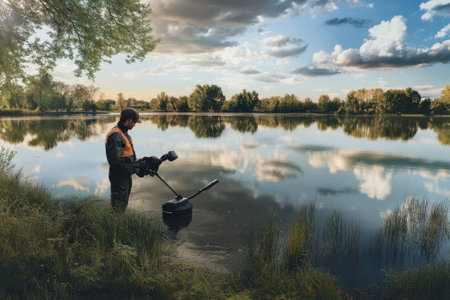Snags and Tangles: Getting Unstuck Fast
Troubleshooting the Most Common Fishing Hassles
Every angler, especially beginners, faces the frustration of tangled lines and snagged hooks. The good news? With a few quick fixes, you can get back to fishing in no time. Here are some practical tips for handling these common problems on American lakes and rivers.
Tips for Untangling Fishing Lines
Stay calm—yanking on a tangled line usually makes it worse. Instead, loosen the drag on your reel and gently pull out loops one at a time. If knots form, try using a safety pin or the point of a hook to tease them apart. Always keep your fingers wet when working with monofilament to reduce friction and prevent weakening the line.
Freeing Hooks from Underwater Obstacles
If your hook gets snagged under water, don’t jerk your rod; this can break your line or bend the hook. Point your rod tip directly at the snag and give your line a series of short, sharp tugs. Sometimes changing the angle by moving down the bank helps free the hook. Carrying a long stick or collapsible pole is handy for reaching into shallow water snags.
Handling Snags with Minimal Frustration
Plan ahead by using weedless hooks or adding a bobber to keep your bait above trouble spots. When fishing around heavy cover, use heavier test line so you have extra strength if you need to pull free. And remember, snags happen to everyone—even seasoned anglers—so treat them as part of the adventure rather than a setback.
Pro Tip:
A small pair of scissors or line cutters in your tackle box can save the day when you need to quickly trim away hopeless tangles or retie after escaping a stubborn snag.
2. When Fish Wont Bite: Quick Solutions
It’s a common frustration—your line is in the water, but nothing’s happening. Don’t let it ruin your day! There are some fast and effective fixes you can try right away to turn things around. Here’s what to do when the fish just aren’t biting:
Immediate Actions You Can Take
| Action | How to Do It | Why It Works |
|---|---|---|
| Switch Lures | Change color, size, or type (from spinner to soft bait, for example) | Different lures attract different fish; sometimes they want something new |
| Adjust Your Bait | Try live bait instead of artificial, or vice versa. Use fresher or scented options. | Fish can be picky—changing the smell or movement can draw more attention |
| Change Fishing Spot | Move a few yards down the bank, cast from a new angle, or try deeper/shallow water | Fish move around; if they’re not here, they could be just a little further out |
Pro Tips for Fast Troubleshooting
- Observe Other Anglers: See what’s working for people nearby and don’t be afraid to ask for advice. Most American anglers are happy to share tips with beginners!
- Tune Into Nature: Notice where birds are diving or insects are swarming—fish often follow food sources.
- Stay Flexible: The most successful fishermen adapt quickly. If something isn’t working after 10-15 minutes, switch it up.
Quick Checklist Before You Move On
- Lure changed at least once?
- Bait checked and refreshed?
- Tried casting in a new spot or depth?
- Adjusted retrieval speed or technique?
- Taken a break and returned after letting the area settle?
The Bottom Line:
If you’re not getting bites, don’t just sit and wait! Mix up your tactics, move locations, and keep experimenting until you find what works. Being proactive is key to landing that catch and making your fishing trip a success.
![]()
3. Gear Glitches: Emergency Repairs
When you’re out on the water, gear malfunctions can turn a relaxing day into a stressful one. Beginners often face issues like broken rods, loose reels, or missing tackle, but knowing some quick fixes can save your trip. First off, if you snap your rod tip, don’t panic. Grab some duct tape (a must-have in any tackle box) and a sturdy stick to make a splint—wrap it tightly around the break for a temporary fix strong enough to finish the day.
Dealing with Loose Reels
A wobbly reel can mess up your casting and reeling in fish. Always pack a small screwdriver or multi-tool. Tighten any screws on the reel seat and handle; if they’re stripped, a bit of electrical tape wrapped around the base can hold things steady until you get home for a proper repair. If your reel keeps slipping on the rod, use rubber bands or even a few zip ties to secure it temporarily.
What If You Lose Tackle?
Losing hooks or weights happens to everyone—especially beginners. Keep an emergency stash of basic tackle in a separate ziplock bag deep in your backpack. If you run out, improvise: fashion a hook from a paper clip or safety pin, and use small pebbles or nuts as makeshift sinkers by tying them securely to your line.
Pro Tip: The Survival Mindset
Always think like a problem-solver. Americans are known for their “can-do” attitude—so whether you’re patching up broken gear with paracord or repurposing everyday items for fishing, stay flexible and creative. With these quick fixes in your back pocket, you’ll never have to cut an adventure short just because of minor gear glitches.
4. Casting Woes: Improving Accuracy on the Spot
Every beginner angler faces casting troubles from time to time, whether it’s a nasty backlash, a cast that falls short, or accidentally spooking fish with a noisy entry. The good news? There are some tried-and-true quick fixes you can use right at the water’s edge to get your line where it needs to go and keep your fishing game strong.
Quick Fixes for Common Casting Mistakes
| Mistake | Quick Fix | Pro Tip |
|---|---|---|
| Backlash (Birds Nest) | Stop reeling immediately. Gently pull out loose line by hand until the tangle loosens, then reel in slowly while keeping tension on the spool. | Adjust your reel’s brake and spool tension before casting again to prevent repeats. |
| Short Casts | Check for line snags or tangles. Make sure your rod tip is high on the forward motion, and use a smooth, fluid motion rather than muscling it. | Use your wrist for snap power, not just your arm. Let the rod do the work! |
| Spooking Fish | Aim for gentle landings by casting slightly past your target and retrieving quietly into position. | Switch to lighter lures or softer presentations if fish are especially skittish. |
Troubleshooting On the Fly
If you’re getting repeated backlashes, double-check your spool tension and practice feathering the spool with your thumb as the lure lands. For short casts, focus on technique over power—overexertion often leads to less distance and more error. And when it comes to stealth, always try to blend into your environment and minimize sudden movements.
Casting Checklist for Beginners
- Inspect line for knots or twists before each cast.
- Keep an eye on your surroundings—avoid trees, rocks, or docks behind you.
- Practice sidearm casts in windy conditions for better accuracy.
- If all else fails, take a breath and reset—rushed casts rarely hit the mark.
The Takeaway
No angler gets every cast perfect, especially when starting out. But with these quick fixes and a bit of patience, you’ll troubleshoot most casting woes right on the spot—and spend more time fishing instead of untangling!
5. Hooking and Landing Fish: Problems and Solutions
Troubleshooting Missed Hookups
Missing fish when they bite is a classic beginner frustration. Often, it’s about timing and technique. Make sure you’re using the right hook size for your target species—too big or too small can both lead to missed hookups. When you feel a bite, avoid yanking the rod immediately. Instead, wait for a steady pull before setting the hook with a smooth, firm motion. For bass and other hard-mouthed fish, use a sweeping hookset. For trout or panfish, a gentle wrist flick does the trick.
Dealing With Lost Fish During the Fight
Losing a fish mid-fight often comes down to line tension or improper rod angle. Keep your line tight at all times—any slack gives the fish a chance to spit the hook. If the fish runs, let your drag do its job instead of locking down or reeling against it. Always keep your rod tip up and maintain pressure, steering the fish away from cover where it could break off. If you’re losing fish right at the boat or shore, check that your hooks are sharp and not bent out of shape after each catch.
Safe and Effective Landing Techniques
Landing fish safely means thinking about both your success rate and the welfare of the fish (especially if practicing catch-and-release). Use a landing net whenever possible—it reduces stress on the fish and prevents last-second escapes. Wet your hands before handling any catch to protect their slime coat. Grasp larger fish gently behind the head or under the belly; for smaller species, cradle them softly in your palm. Avoid dragging fish onto rocks or dirt, which can injure them and make release less likely.
Pro Tip: Practice Makes Perfect
The more time you spend on the water, the better your hookup ratio and landing skills will get. Don’t get discouraged by early mistakes—they’re all part of becoming a confident angler!
6. Weather and Water Changes: Adapting Instantly
If you’ve been out fishing for more than five minutes, you already know that Mother Nature loves to keep anglers on their toes. Sudden wind gusts, unexpected rain, or shifting water clarity can throw your whole game off. But don’t pack up yet—being able to quickly adapt is what separates a rookie from a seasoned angler.
Windy Conditions? Adjust Your Cast and Bait
When the wind picks up, casting accuracy can tank. Switch to heavier lures or weights to cut through the gusts, and cast low to keep your line under the wind. Fish often move closer to shore when it’s windy, so try targeting those areas instead of open water.
Rain: Opportunity in Disguise
A light rain can actually get fish feeding. Use brighter colored lures or baits with strong scents to help fish find your offering in murky water. Just be careful—slick banks and docks call for extra caution.
Water Clarity and Temperature Shifts
Murky water after a storm? Go for noisy lures or those with lots of vibration so fish can locate them by sound. If the temperature drops suddenly, fish may slow down; try downsizing your bait and slowing your retrieve.
Pro Tip: Always Keep Extra Gear Handy
Pack a range of lure types, spare weights, and even rain gear in your tackle box. This way, you’re ready for whatever the weather throws at you—and you won’t have to call it quits just because the skies change.
Stay Flexible, Stay Fishing
The best anglers are quick thinkers who adjust on the fly. Embrace changing conditions as part of the adventure. With these quick fixes, you’ll keep catching fish no matter what surprises nature sends your way.


